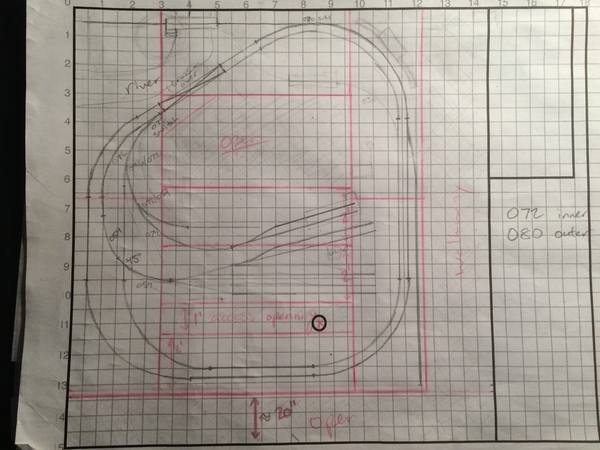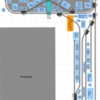After several years of planning and preparing, I have finally started work on a basement layout. The layout is approximately 12' by 13' (more precisely, 12' 1" by 13' 4"). The reason for these dimensions is the layout is being built on top of solid core doors, most being 6' 8" long. The doors are supported by steel table legs for shelving units. This has made construction of the benchwork move very fast with almost no cutting save for a notch where a column is located. The pieces are then strapped together from the underside. This yields a modular system that can be disassembled and transported in the future.
The plan that I had drawn up was a two-track mainline (O72 and O80), along with a yard, engine service facility, and REA freight depot that curve into the center of the layout. There is also a place for a river and a postwar 313 Bascule Bridge spanning it that I purchased from a friend.
I have had this plan drawn up for the past year or so. On Sunday, construction of the benchwork began. Here are before and after shots.
As construction on the tables progressed, things began to change. The plan called for an opening that was 3' x 6'8" where I would control the trains from. As the perimeter tables went up, the large open area in the center was calling to me. The larger opening allowed more space to move around. So, after over a year set on the plan shown above, I quickly set to work on a new plan. This plan has the larger open area in the middle with 3' tables on three sides and 30" tables on the remaining side. With the center section removed, the yard had to be relocated. I now have it sketched out to be on the 3' door along the far wall.
This is the new plan I drew Sunday night. It shows the rail yard and engine service facility along the left wall. I added a slight S-curve along that wall as well to break up the monotony of trains only turning one direction ( a short straight is called for larger engines/trains to traverse it better). The tables on the right have a couple industrial sidings for switching operations. Sadly, there is no place for the bascule bridge in this plan, so I will put it on display somewhere instead. This revision simplifies the track plan significantly. The previous plan had some fancy track-work on the yard throat to maximize the tracks coming of the Ross 4-way. The new plan will have much longer yard tracks and very simple track-work. I also believe this plan has longer mainlines because they do not cut diagonally across in the top left corner as they did in my original sketch. Even better, my new track plan has a much larger area for the town. The previous plan had a smaller town due to the river and bascule bridge scene in the upper left corner.
I will continue to update this thread as progress is made. I look forward to any feedback that my fellow hobbyists have to offer. Happy railroading and Happy New Year, too!






















